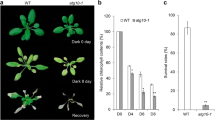Abstract
Leaves of eight species of Leguminosae-Papilionoideae were examined for the presence of a highly specialized cell layer called the paraveinal mesophyli (PVM). Three species, Glycine max (L.) Merr, Psophocarpus tetragonolobus D.C. and Vigna radiata L., contained PVM; five (Medicago sativa L., Phaseolus vulgaris L., Pisum sativum L., Vicia faba L., Vigna unguiculata L.) did not. The PVM of G. max and P. tetragonolobus was anatomically identical and consisted of large, interconnected, multiarmed cells forming a network, one cell thick, spanning the region between vascular bundles and abutting the bundle sheath at the level of the phloem. The PVM of V. radiata differed in that elaborate extensions of individual bundle-sheath cells comprised the entire intervascular network. The PVM cells of all three species were large, contained a dense, thin peripheral layer of cytoplasm, and a large central vacuole. The cytoplasm contained few small chloroplasts and few microbodies, but was enriched in rough endoplasmic reticulum. Plasmodesmata were common in crosswalls between adjacent PVM cells and between PVM cells and other cell types abutting them. Vacuolar material was present in all three species, but was variable in appearance. That of G. max was present in large amounts, semifibrillar and finely dispersed. That of P. tetragonolobus was also present in large amounts but primarily as large aggregates, although some fibrillar material was also present. Vigna radiata had small amounts of vacuolar material evenly distributed between small aggregates and dispersed fibrils. Removal of flowers or young pods resulted in further increase of the vacuolar material in G. max PVM and increase of the fibrillar material in P. tetragonolobus, but had no appreciable affect on the vacuolar material in V. radiata. Histochemical staining indicated the vacuolar material in G. max and P. tetragonolobus was proteinaceous.
Similar content being viewed by others
Abbreviations
- PTA:
-
phosphotungstic acid
- PVM:
-
paraveinal mesophyll
References
Fisher, D.B. (1967) An unusual layer of cells in the mesophyll of the soybean leaf. Bot. Gaz. (Chicago) 128, 215–218
Franceschi, V.R., Giaquinta, R.T. (1983a) The paraveinal mesophyll of soybean leaves in relation to assimilate transfer and compartmentation. I. Ultrastructure and histochemistry during vegetative development. Planta 154, 411–421
Franceschi, V.R., Giaquinta, R.T. (1983b) The paraveinal mesophyll of soybean leaves in relation to assimilate transfer and compartmentation. II. Structural, metabolic and compartment changes during reproductive growth. Planta 154, 422–431
Franceschi, V.R., Wittenbach, V.A., Giaquinta, R.T. (1983) The paraveinal mesophyll of soybean leaves in relation to assimilate transfer and compartmentation. III. Immunohistochemical localization of specific glycopeptides in the vacuole after depodding. Plant Physiol. 72, 586–589
Giaquinta, R.T. (1983) Phloem loading of sucrose. Annu. Rev. Plant Physiol. 34, 347–387
Haberlandt, G. (1914) Physiological plant anatomy (Engl. transln.) MacMillan, London
Hurkman, W.J., Kennedy, G.S. (1976) Fine structure and development of protoplasts in primary leaves of mung bean. Protoplasma 89, 171–184
Weaver, R.W., Morris, D.R. (1982) Mobilization of labelled N in soybean leaves during early podfill. J. Plant Nutr. 5, 1099–1108
Author information
Authors and Affiliations
Additional information
Contribution No. 3215 from the Central Research and Development Department, E.I. du Pont de Nemours & Co
Rights and permissions
About this article
Cite this article
Franceschi, V.R., Giaquinta, R.T. Specialized cellular arrangements in legume leaves in relation to assimilate transport and compartmentation: comparison of the paraveinal mesophyll. Planta 159, 415–422 (1983). https://doi.org/10.1007/BF00392077
Received:
Accepted:
Issue Date:
DOI: https://doi.org/10.1007/BF00392077




